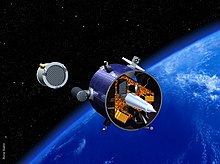Lunar Prospector
[4][5] Lunar Prospector was the third mission selected by NASA for full development and construction as part of the Discovery Program.
[6] It was managed by NASA Ames Research Center with the prime contractor being Lockheed Martin; it cost $62.8 million.
His personal account of the mission, Lunar Prospector: Against all Odds, is highly critical of the bureaucracy of NASA overall, and of its contractors.
The probe also carried a small amount of the remains of Eugene Shoemaker (April 28, 1928 – July 18, 1997), astrogeologist[8][9] and co-discoverer of Comet Shoemaker-Levy 9, to the Moon for a space burial.
In 2013 an unidentified piece of space junk was discovered in an unstable orbit around the Earth, and assigned the provisional number WT1190F.
The GRS was a small cylinder which was mounted on the end of one of the three 2.5 m (8 ft 2 in) radial booms extending from Lunar Prospector.
Due to a low signal-to-noise ratio, multiple passes were required to generate statistically significant results.
[12] The fundamental purpose of the GRS experiment was to provide global maps of elemental abundances on the lunar surface.
Differences in the counts between the two canisters indicate the number of thermal neutrons detected, which in turn indicates the amount of hydrogen in the Moon's crust at a given location.
For the polar ice studies, the NS was slated to examine the poles to 80 degrees latitude, with a sensitivity of at least 10 ppm by volume of hydrogen.
A high voltage is applied to the silicon, and the current is amplified by being funneled along the tracks to the aluminum disk and is recorded for identification.
The APS was designed to make a global examination of gas release events and polonium distribution with a surface resolution of 150 km (93 mi) and a precision of 10%.
The APS recorded alpha particle signatures of radioactive decay of radon gas and its byproduct product, polonium.
These putative outgassing events, in which radon, nitrogen, and carbon dioxide are vented, are hypothesized to be the source of the tenuous lunar atmosphere, and may be the result of the low-level volcanic/tectonic activity on the Moon.
Information on the existence, timing, and sources of these events may help in a determination of the style and rate of lunar tectonics.
Additionally, due to sunspot activity peaking during the mission, the lunar data was obscured by solar interference.
This is accomplished by measuring the Doppler shift in the S-band tracking signal as it reaches Earth, which can be converted to spacecraft accelerations.
The accelerations can be processed to provide estimates of the lunar gravity field, from which the location and size of mass anomalies affecting the spacecraft orbit can be modeled.
The experiment was designed to give the near-side gravity field with a surface resolution of 200 km (120 mi) and precision of 5 mGal (0.05 mm/s²) in the form of spherical harmonic coefficients to degree and order 60.
the Moon's overall magnetic field is too weak to deflect the solar wind, but MAG/ER discovered a small surface anomaly that can do so.
Since hydrogen density is a desirable characteristic for hypothetical lunar bases, this information may be useful in choosing optimal sites for possible long-term Moon missions.
The electron reflectometer (ER) and magnetometer (MAG) were designed to collect information on the lunar magnetic fields.
The instrument measured the pitch angles of solar wind electrons reflected from the Moon by lunar magnetic fields.
Field strengths as small as 0.01 nT could be measured with a spatial accuracy of about 3 km (1.9 mi) at the lunar surface.
It could measure the magnetic field amplitude and direction at spacecraft altitude with a spatial resolution of about 100 km (62 mi) when ambient plasma disturbances are minimal.



Lunar Prospector · Moon

Lunar Prospector Moon









